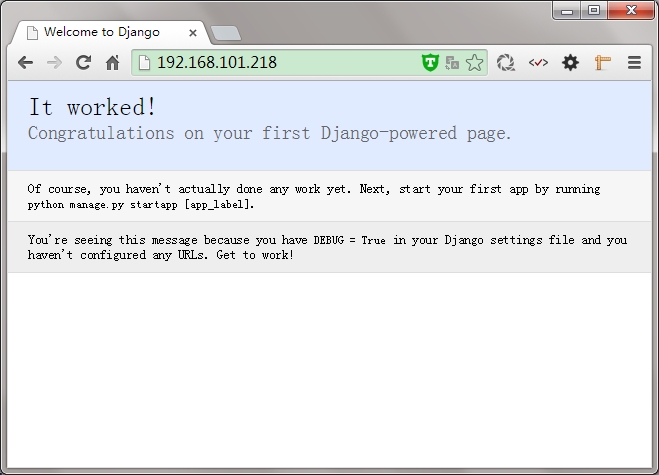環境介紹:
[root@localhost opsdev]# nginx -v Tengine version: Tengine/2.0.3 (nginx/1.4.7) [root@localhost opsdev]# cat /etc/redhat-release CentOS release 6.4 (Final) [root@localhost opsdev]# uwsgi -v uwsgi: option requires an argument -- 'v' getopt_long() error [root@localhost opsdev]# uwsgi --version 2.0.9 [root@localhost opsdev]# django -v -bash: django: command not found [root@localhost opsdev]# python -c "import django;print (django.get_version())" 1.7.2 [root@localhost opsdev]# [root@localhost opsdev]# python -V Python 2.7.6
Come on~
1、安裝nginx
[root@localhost tmp]# yum install pcre pcre-devel -y [root@localhost tmp]# tar xf tengine-2.0.3.tar.gz [root@localhost tmp]# cd tengine-2.0.3 [root@localhost tmp]# ./configure --prefix=/usr/local/nginx --conf-path=/etc/nginx/nginx.conf --error-log-path=/var/log/nginx/error.log --http-log-path=/var/log/nginx/access.log --with-http_stub_status_module --with-pcre --with-file-aio --with-http_flv_module --with-http_gzip_static_module --http-client-body-temp-path=/var/tmp/nginx/client/ --http-proxy-temp-path=/var/tmp/nginx/proxy/ --http-fastcgi-temp-path=/var/tmp/nginx/fcgi/ --http-uwsgi-temp-path=/var/tmp/nginx/uwsgi --http-scgi-temp-path=/var/tmp/nginx/scgi [root@localhost tmp]# make && make install
相關選項
--prefix=/usr/local/nginx 安裝目錄 --conf-path=/etc/nginx/nginx.conf 配置文件存放位置 --error-log-path=/var/log/nginx/error.log 錯誤日誌存放位置 --http-log-path=/var/log/nginx/access.log 訪問日誌存放的位置 --with-http_ssl_module 啓用SSL認證模塊 --with-http_flv_module 啓用流媒體模塊 --with-http_gzip_static_module 啓用靜態頁面壓縮 --http-client-body-temp-path=/var/tmp/nginx/client/ HTTP包體存放的臨時目錄 --http-proxy-temp-path=/var/tmp/nginx/proxy/ 定義從後端服務器接收的臨時文件的存放路徑,可以爲臨時文件路徑定義至多三層子目錄的目錄樹 --http-fastcgi-temp-path=/var/tmp/nginx/fcgi/ 接收到FastCGI服務器數據,臨時存放於本地某目錄 --with-pcre 啓動正則表達式rewrite模塊
添加nginx二進制路徑到PATH
[root@localhost tengine-2.0.3]# vim /etc/profile.d/nginx.sh [root@localhost tengine-2.0.3]# cat /etc/profile.d/nginx.sh export PATH=$PATH:/usr/local/nginx/sbin/ [root@localhost tengine-2.0.3]# source /etc/profile.d/nginx.sh [root@localhost tengine-2.0.3]# nginx -v Tengine version: Tengine/2.0.3 (nginx/1.4.7)
導出頭文件
[root@localhost tengine-2.0.3]# ln -sv /usr/local/nginx/include/ /usr/include/nginx `/usr/include/nginx' -> `/usr/local/nginx/include/'
爲tengine提供Sysv服務腳本
#!/bin/sh
#
# nginx - this script starts and stops the nginx daemin
#
# chkconfig: - 85 15
# description: Nginx is an HTTP(S) server, HTTP(S) reverse \
# proxy and IMAP/POP3 proxy server
# processname: nginx
# config: /usr/local/nginx/conf/nginx.conf
# pidfile: /usr/local/nginx/logs/nginx.pid
# Source function library.
. /etc/rc.d/init.d/functions
# Source networking configuration.
. /etc/sysconfig/network
# Check that networking is up.
[ "$NETWORKING" = "no" ] && exit 0
nginx="/usr/local/nginx/sbin/nginx"
prog=$(basename $nginx)
NGINX_CONF_FILE="/etc/nginx/nginx.conf"
lockfile=/var/lock/subsys/nginx
start() {
[ -x $nginx ] || exit 5
[ -f $NGINX_CONF_FILE ] || exit 6
echo -n $"Starting $prog: "
daemon $nginx -c $NGINX_CONF_FILE
retval=$?
echo
[ $retval -eq 0 ] && touch $lockfile
return $retval
}
stop() {
echo -n $"Stopping $prog: "
killproc $prog -QUIT
retval=$?
echo
[ $retval -eq 0 ] && rm -f $lockfile
return $retval
}
restart() {
configtest || return $?
stop
start
}
reload() {
configtest || return $?
echo -n $"Reloading $prog: "
killproc $nginx -HUP
RETVAL=$?
echo
}
force_reload() {
restart
}
configtest() {
$nginx -t -c $NGINX_CONF_FILE
}
rh_status() {
status $prog
}
rh_status_q() {
rh_status >/dev/null 2>&1
}
case "$1" in
start)
rh_status_q && exit 0
$1
;;
stop)
rh_status_q || exit 0
$1
;;
restart|configtest)
$1
;;
reload)
rh_status_q || exit 7
$1
;;
force-reload)
force_reload
;;
status)
rh_status
;;
condrestart|try-restart)
rh_status_q || exit 0
;;
*)
echo $"Usage: $0 {start|stop|status|restart|condrestart|try-restart|reload|force-reload|configtest}"
exit 2
esac把該腳本放到/etc/init.d目錄下並賦予該腳本權限
[root@localhost tmp]# mv nginx /etc/init.d/nginx [root@localhost tmp]# chmod +x /etc/init.d/nginx
添加到開機啓動項並啓動服務
[root@localhost tmp]# chkconfig --add nginx [root@localhost tmp]# chkconfig --level 35 nginx on [root@localhost tmp]# chkconfig --list | grep nginx nginx 0:off 1:off 2:off 3:on 4:off 5:on 6:off [root@localhost tmp]#
啓動服務
[root@localhost init.d]# service nginx restart
the configuration file /etc/nginx/nginx.conf syntax is ok
configuration file /etc/nginx/nginx.conf test is successful
Stopping nginx: [ OK ]
Starting nginx: [ OK ]
[root@localhost init.d]# ss -tunlp | grep 80
tcp LISTEN 0 128 *:80 *:* users:(("nginx",7602,6),("nginx",7604,6))
[root@localhost init.d]#2、升級Python
爲毛要升級Python呢,因爲django1.5之後的版本導入django core是使用推導式的,而推導式list是python2.7之後才支持的,so~
如果你建立django項目的時候出現如下報錯,請升級你的Python或降級django版本
commands = {name: 'django.core' for name in find_commands(__path__[0])}
^
SyntaxError: invalid syntax我們這裏安裝python 2.7.5
[root@localhost tmp]# wget --no-check-certificate [root@localhost tmp]# tar -xzvf Python-2.7.5.tgz [root@localhost tmp]# cd Python-2.7.5 [root@localhost Python-2.7.5]# ./configure [root@localhost Python-2.7.5]# make && make install [root@localhost Python-2.7.5]# mv /usr/bin/python /usr/bin/python.bak [root@localhost Python-2.7.5]# ln -s /usr/local/bin/python2.7 /usr/bin/python
修復yum,修改後/usr/bin/yum第一行如下所示
[root@localhost tmp]# vim /usr/bin/yum #!/usr/bin/python2.6
安裝pip(如果你更新python之前安裝過pip,這個時候多半是不能用的,建議從官網從新下載安裝)
常見報錯如下:
Traceback (most recent call last): File "/usr/bin/pelican-quickstart", line 5, in <module> from pkg_resources import load_entry_pointImportError: No module named pkg_resources
解決辦法:
重新安裝setuptools和pip即可解決
3、安裝django並創建項目
安裝django
[root@localhost ~]# pip install django
創建項目(在nginx定義的目錄下面)
[root@localhost www]# django-admin startproject opsdev
4、安裝uwsgi
安裝uwsgi
[root@localhost opsdev]# pip install uwsgi
測試
#test.py
def application(env,start_response):
start_response('200 OK',[('Content-Type','text/html')])
return ["hello world"]運行並查看結果
uwsgi:uwsgi --http :9090 --wsgi-file test.py
5、uwsgi配置django
創建django_wsgi.py文件(和mange.py同級目錄)
[root@localhost opsdev]# ls
db.sqlite3 django_wsgi.py manage.py opsdev
django_wsgi.pyc media static
[root@localhost opsdev]# cat django_wsgi.py
#!/usr/bin/env python
# coding: utf-8
import os
import sys
# 將系統的編碼設置爲UTF8
#reload(sys)
#sys.setdefaultencoding('utf8')
#注意:"mysite.settings" 和項目文件夾對應。
os.environ.setdefault("DJANGO_SETTINGS_MODULE", "opsdev.settings")
#from django.core.handlers.wsgi import WSGIHandler
#application = WSGIHandler()
# 上面兩行測試不對,然後從stackflow上面看到了下面兩行,測試ok
from django.core.wsgi import get_wsgi_application
application = get_wsgi_application()
[root@localhost opsdev]#創建django_socket.xml文件(和mange.py同級目錄)
[root@localhost opsdev]# cat django_socket.xml <uwsgi> <socket>127.0.0.1:8077</socket> <!-- 和nginx中定義的要一致 --> <chdir>/www/opsdev</chdir> <!-- 你django的項目目錄 --> <module>django_wsgi</module> <!-- 名稱爲剛纔上面定義的py文件名 --> <processes>4</processes> <!-- 進程數 --> <daemonize>/var/log/uwsgi.log</daemonize> </uwsgi> [root@localhost opsdev]# ls db.sqlite3 django_wsgi.py manage.py opsdev django_socket.xml django_wsgi.pyc media static [root@localhost opsdev]#
驗證是否能夠正常訪問
[root@localhost opsdev]# uwsgi --http :8000 --chdir /www/opsdev/ --wsgi-file django_wsgi.py *** Starting uWSGI 2.0.9 (64bit) on [Thu Jan 8 12:21:15 2015] *** compiled with version: 4.4.7 20120313 (Red Hat 4.4.7-11) on 07 January 2015 23:29:52 os: Linux-2.6.32-358.el6.x86_64 #1 SMP Fri Feb 22 00:31:26 UTC 2013 nodename: localhost.localdomain
如果上面沒有出錯,就說明uwsgi和django結合完畢
6、配置nginx配置文件(其他未做更改)
location / {
include uwsgi_params;
uwsgi_pass 127.0.0.1:8077;
}
location /static/ {
alias /www/opsdev/static/;
index index.html index.htm;
}
location /media/ {
alias /www/opsdev/media/;
}7、啓動測試
啓動uwsgi
[root@localhost opsdev]# uwsgi -x django_socket.xml [uWSGI] parsing config file django_socket.xml [root@localhost opsdev]#
啓動nginx
[root@localhost opsdev]# service nginx start Starting nginx: [ OK ] [root@localhost opsdev]#
查看進程
[root@localhost opsdev]# ss -tunlp
Netid State Recv-Q Send-Q Local Address:Port Peer Address:Port
tcp LISTEN 0 100 127.0.0.1:8077 *:* users:(("uwsgi",25703,3),("uwsgi",25704,3),("uwsgi",25705,3),("uwsgi",25706,3))
tcp LISTEN 0 128 *:80 *:* users:(("nginx",26427,6),("nginx",26429,6))查看結果
常見FAQ:
uwsgi: invalid option -- 'x' getopt_long() error
解決辦法:用“ yum install libxml*”即可解決。安裝uwsgi時看到 “xml = libxml2”就表示成功了
“The translation infrastructure cannot be initialized before the ”
django.core.exceptions.AppRegistryNotReady: The translation infrastructure cannot be initialized before the apps registry is ready. Check that you don’t make non-lazy gettext calls at import time.
解決辦法(修改django_wsgi.py):
原來: import django.core.handlers.wsgi application = django.core.handlers.wsgi.WSGIHandler() 改成: from django.core.wsgi import get_wsgi_application application = get_wsgi_application() 重啓一下uwsgi。
no python application found, check your startup logs for errorsGET / => generated 21 bytes in 0 msecs (HTTP/1.1 500) 2 headers in 83 bytes (0 switches on core 0)
解決辦法:檢查django_wsgi.py配置文件,然後uwsgi單獨訪問下是否正常
還有很多東東要做,臥槽類。。。。
參考文檔:在此表示謝謝!
http://stackoverflow.com/questions/22148144/python-importerror-no-module-named-pkg-resourceshttps://github.com/imelucifer/MyNote/blob/master/django/django%2Buwsgi%2Bnginx%2Bcentos%E9%83%A8%E7%BD%B2.mdhttp://www.aaini.com/

